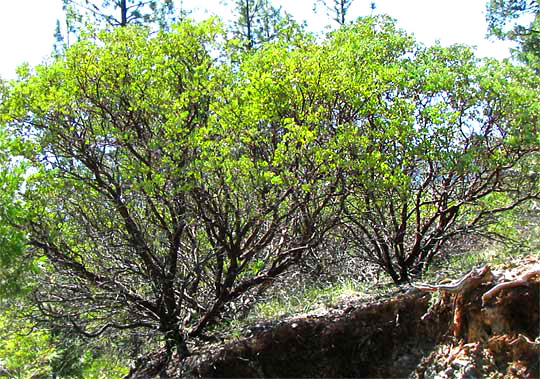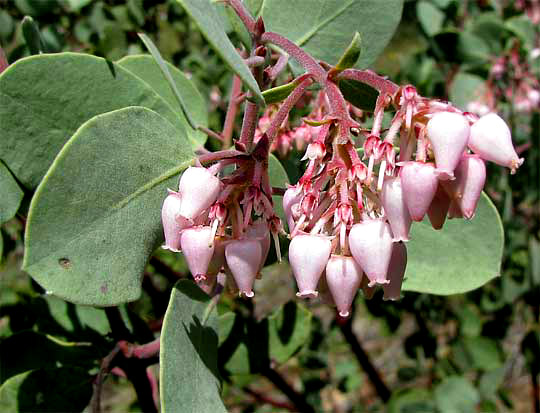Excerpts from Jim Conrad's
Naturalist Newsletter
from the April 19, 2009 Newsletter, issued from the Siskiyou Mountains west of Grants Pass, Oregon:
WHITELEAF MANZANITA
On our mountain slopes where tall, lush conifer forest gives way to serpentine barrens, roadsides, or wherever it's a bit dry and the light gets in, you get the much-branching, rusty-red-stemmed bush or small tree growing to ten feet or so high known as Whiteleaf Manzanita, ARCTOSTAPHYLOS VISCIDA. You can see two manzanitas and how profusely they branch below:

Sometimes you run into manzanita thickets so dense you can't even crawl through them. People around here usually have a clear-away-the-underbrush frame of mind because of the summer dry-season fire hazard and they don't care much for manzanita -- except as firewood. "You put pine in your stove and it'll burn up before you know it, but manzanita lasts and lasts and doesn't make a mess," a friend tells me.
The name "manzanita" is Spanish meaning "little apple" because the shrub's fruit is like a 1/3-inch-across, shiny-red to greenish brown crabapple, mealy and full of seeds, so wildlife like it. I read that the Miwok indigenous people of northern California once made cider from the fruits.
When you see how quickly the species invades along logging roads you can imagine legions of birds, bears and others dropping their manzanita-seed-filled poop there. Also, Whiteleaf Manzanita is one of the first woody plants to colonize ground after fire. I read that its seeds require fire for germination, though I see it invading areas where I doubt there's been recent fire.
The reason I'm thinking about Whiteleaf Manzanita now is that it's flowering, as you can see below:

If you notice a similarity between manzanita's flowers and those of blueberries or heath it's because those bushes along with manzanita are members of the Heath or Rhododendron Family, the Ericaceae. Cylindrical corollas with bulging bases tapering to narrow openings rimmed by four or five tiny lobes is typical for that family. There's a neat term applying to corollas of that shape, which are regarded as "urn shaped," and that's "urceolate."
Whiteleaf Manzanita is native only to Oregon and California.